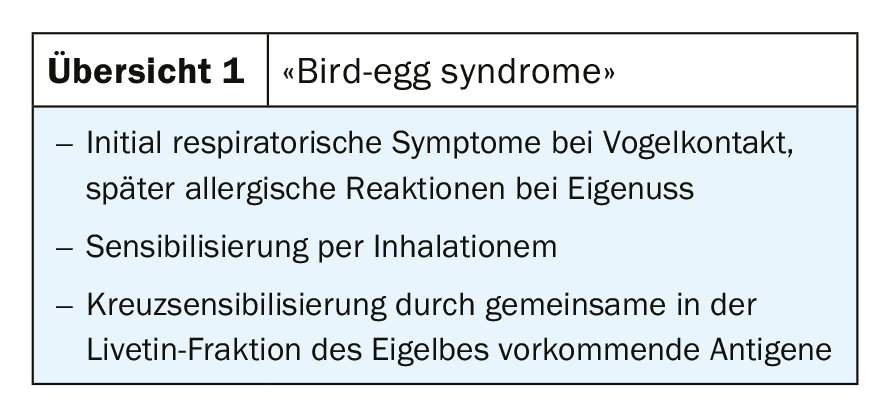Bird-egg syndrome was described in 1988 by Mandallaz et al. described and published in 1990 by de Blay et al. confirmed by means of a casuistry. RAST inhibition was used to support the hypothesis that this clinical picture is caused by cross-sensitization, with the major cross-reacting antigens present in the livetin fraction of the egg yolk.
Anamnesis: The 11-year-old boy J. Marc had a high-grade chicken egg allergy since early childhood. The first administration of egg yolk at 5 months of age immediately resulted in generalized flushing with urticaria. The same symptoms with Quincke’s edema occurred one month later after ingestion of an egg. Since then, an egg-free diet has been consistently followed. Recurrences occurred with minor dietary errors, such as eating a cookie or a piece of cake with egg yolk glaze. Later, allergy symptoms also occurred after eating chicken meat. During the school period, pollinosis symptoms developed in the months of June and July.
No symptoms occurred during short-term contact with birds, e.g. with relatives. The family subsequently acquired budgies. Respiratory problems (rhinitis, asthma) developed, especially when the cage was cleaned, so the family was forced to give the budgies away. It was referred to the allergy ward USZ by the general practitioner.
Allergological clarification
Prick skin testing demonstrated sensitization to egg yolk and egg white (Fig. 1), feather mixture (chicken, goose, and duck feathers), chicken meat, and grass and rye pollen.
Specific IgE assay (RAST) showed very strong positive results of class 5 to egg yolk and chicken feathers and of class 4 to chicken egg white, ovalbumin, livetin and chicken meat. as well as positive results of RAST class 3 for lysozyme and budgerigar feathers, goose feathers and de-feathers were only slightly positive, budgerigar feathers and budgerigar serum proteins were negative.
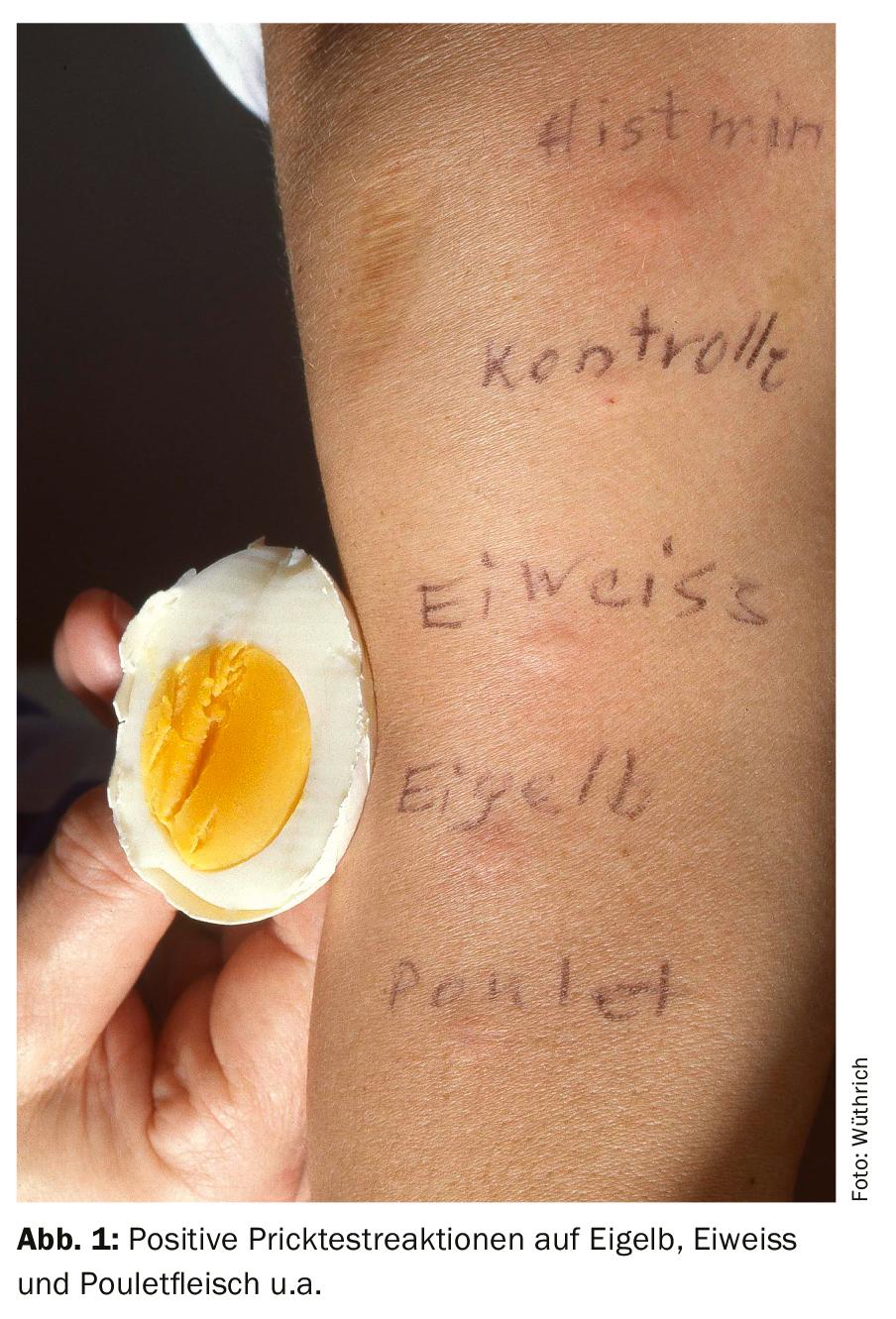
Diagnosis
- “Egg-bird-syndrome” with status post generalized urticaria and Quincke’s edema after Eigenuss and respiratory allergy to budgerigar feces
- Chicken allergy
- Rhinoconjunctivitis pollinosa to grass pollen
Comment
Bird-egg syndrome was described in 1988 by Mandallaz et al. [1] and in 1990 by de Blay et al. [2] confirmed on the basis of a casuistry of 4 cases. RAST inhibition was used to support the hypothesis that this clinical picture is caused by cross-sensitization, i.e., to antibody formation to common antigenic determinants present in egg yolk, feathers, and feces of birds, with the major cross-reacting antigens present in the livetin fraction of egg yolk. A causal relationship between allergy to egg yolk and sensitization to avian serum proteins was pointed out as early as 1985 by De Maat et al. towards [3]. Livetin, which is first described in 1908 [4], is the hydrophilic fraction of egg yolk. Livetin is composed of several protein components-6 major and 4 minor components-and is classified according to electrophoretic mobility into α-, β-, and γ-globulins.
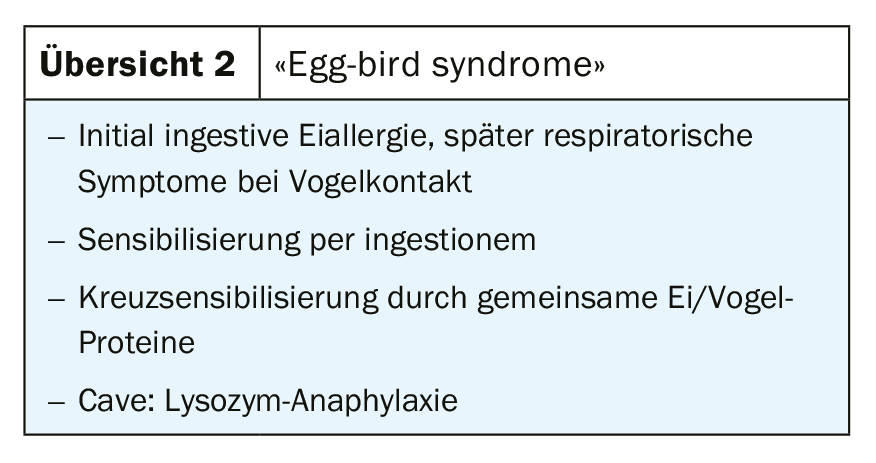
Albumins, transferrin, and γ-globulins were identified as components of avian serum in the livetin fraction [5,6]. This offers itself as an explanation for the cross-sensitization between avian serum proteins and egg yolk (Overview 1), (Case 1, Box). In our case, on the other hand, it is a case of cross-sensitization between egg proteins and bird proteins, in the sense of a “Egg-bird syndromes” [7] (Overview 2). The allergens in the egg yolk are detected in the Overview 3 listed (Fig. 2).
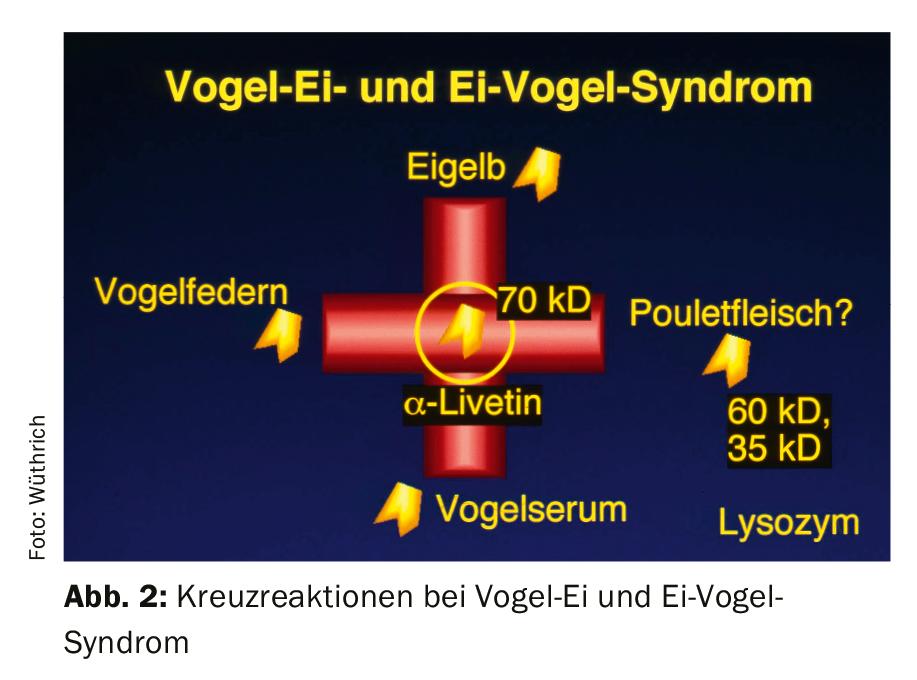
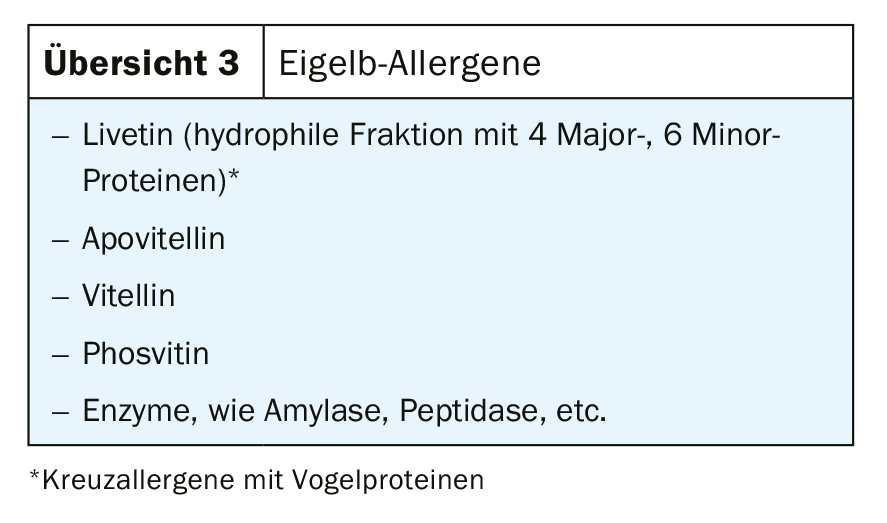
Chicken egg allergy often develops in early childhood. A study in Aarau and Lucerne recorded 151 infants and children (mean age 1.9 yr) diagnosed with food allergy (NMA), with chicken egg identified as the most common trigger at 23.7% [8]. In infants (up to 12 months old), cow’s milk was the most common allergenic food with 37.9% followed by hen’s egg with 31.0% and wheat with 10.3%), in the 2. and in the 3 years of age chicken egg (27.9%), cow’s milk (20.5%), hazelnut (13.1%) and already peanut (10.7%). Hen egg allergy occurs mainly in infants of atopic parents and corresponds to a type A NMA according to Pichler [9]. In childhood, hen egg allergy is mainly due to sensitization to protein proteins, mainly ovalbumin, ovomucoid, and conalbumin (review 4) . [10]. Simultaneous sensitization to egg yolk – as in our case described above – usually occurs only in the case of high-grade egg allergy. Lysozyme is a chicken egg white component (approx. 9 g/l) and is also present in traces in egg yolk. It is a basic protein of 129 amino acids, which has lytic properties on bacterial cell walls. It is also known as muramidase. In contrast to the main protein allergens ovalbumin, ovomucoid and conalbumin, lysozyme is generally considered a weak allergen. However, we reported a case of high-grade lysozyme allergy [7], which is described as case 2 in the box.
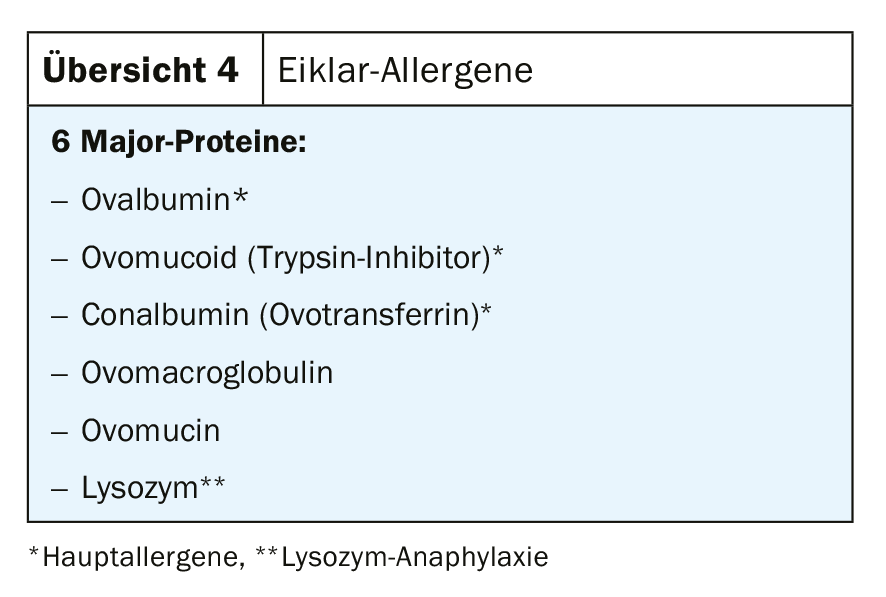
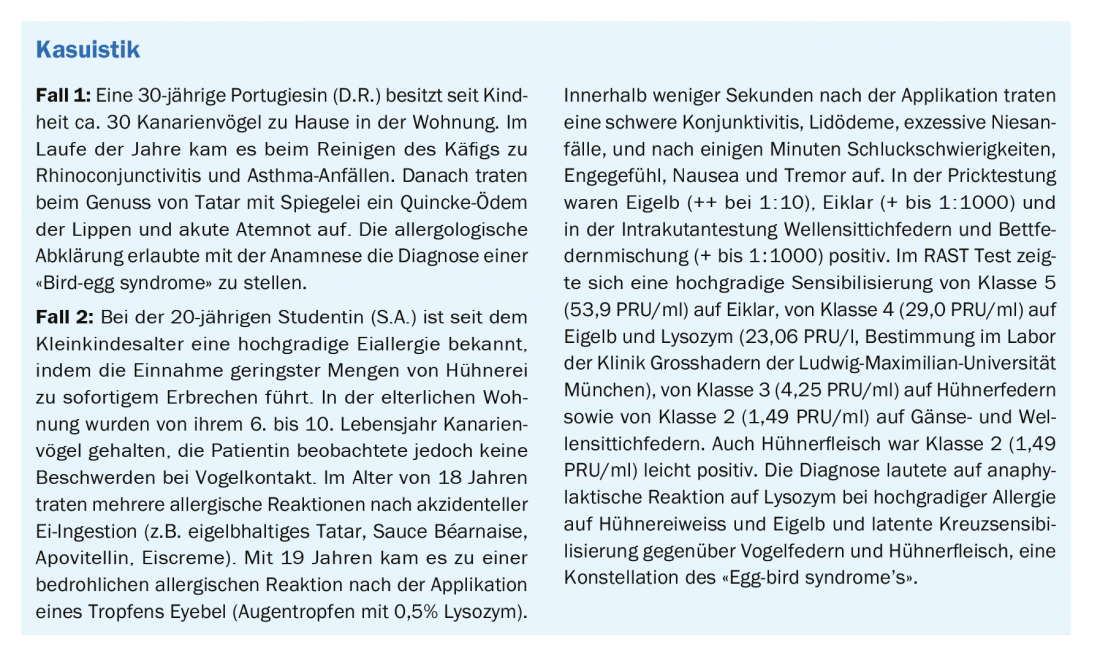
In “Egg-egg syndrome” [11] described for the first time by our research group, an allergy with rhinoconjunctivitis and asthma to egg aerosols, egg white dust or egg spray was first acquired by inhalation at the workplace, e.g. in an industrial bakery or confectionery. Of 4 bakers and 2 pastry chefs studied with respiratory egg allergy and sensitization to various egg proteins, 3 of them later developed allergic symptoms after eating egg dishes. Before the onset of respiratory allergy, they could tolerate eggs without problems.
Literature:
- Mandallaz MM, de Weck AL, Dahinden CA: Bird-Egg Syndrome. Cross-reactivity between bird antigens and egg-yolk livetins in IgE-mediated hypersensitivity. Int Arch Allergy Appl Immunol 1988; 87: 143-150.
- Blay F, de, Hoyet C, Bessot JC, Thierry R, Pauli G: Sensibilisation respiratoire aux protéines aviaires associé à une allergie à l’œuf. Rev fr Allergol 1990; 30: 97-102.
- De Maat-Blecker F, van Dijk AG, Berrens L: Allergy to egg yolk possibly induced by sensitization to bird serum antigens. Ann Allergy 1985; 54: 245-248.
- Plimmer RHA: The proteins of egg-yolk. J Chem Soc 1908; 93: 1500-1506.
- McIndoe WM, Culbert J: The plasma albumin and other livetin proteins in egg yolk of tzhe domestic fowl (gallus domesticus). Int J Biochem 1979; 10: 659-663.
- Williams J: Serum proteins and the livetins of hen’s egg yolk. Biochem J 1962; 83: 346-355.
- Wyss M, Huwyler T, Wüthrich B: Bird-egg and egg-bird syndrome. Cross-sensitization between inhaled and ingestive avian proteins. Allergology 1991; 14: 275-278.
- Ferrari G, Eng P: IgE-mediated food allergies in Swiss infants and children. Swiss Med Wkly 2011; 141:w13269.
- Pichler WJ: IgE-mediated food allergies. Classification based on sensitization pathway. Allergology 1998; 21, 441-450.
- Hoffman DR: Immunochemichal identification of the allergens in egg white. J Allergy Clin Immunol 1983; 71: 481-486.
- Leser C, Hartmann AL, Praml G, Wüthrich B: The “egg-egg” syndrome: occupational respiratory allergy to airborne egg proteins with consecutive ingestive egg allergy in the bakery and confectionery industry. J Investig Allergol Clin Immunol 2001; 11: 89-93.
DERMATOLOGY PRACTICE 2020; 30(2): 6-8



